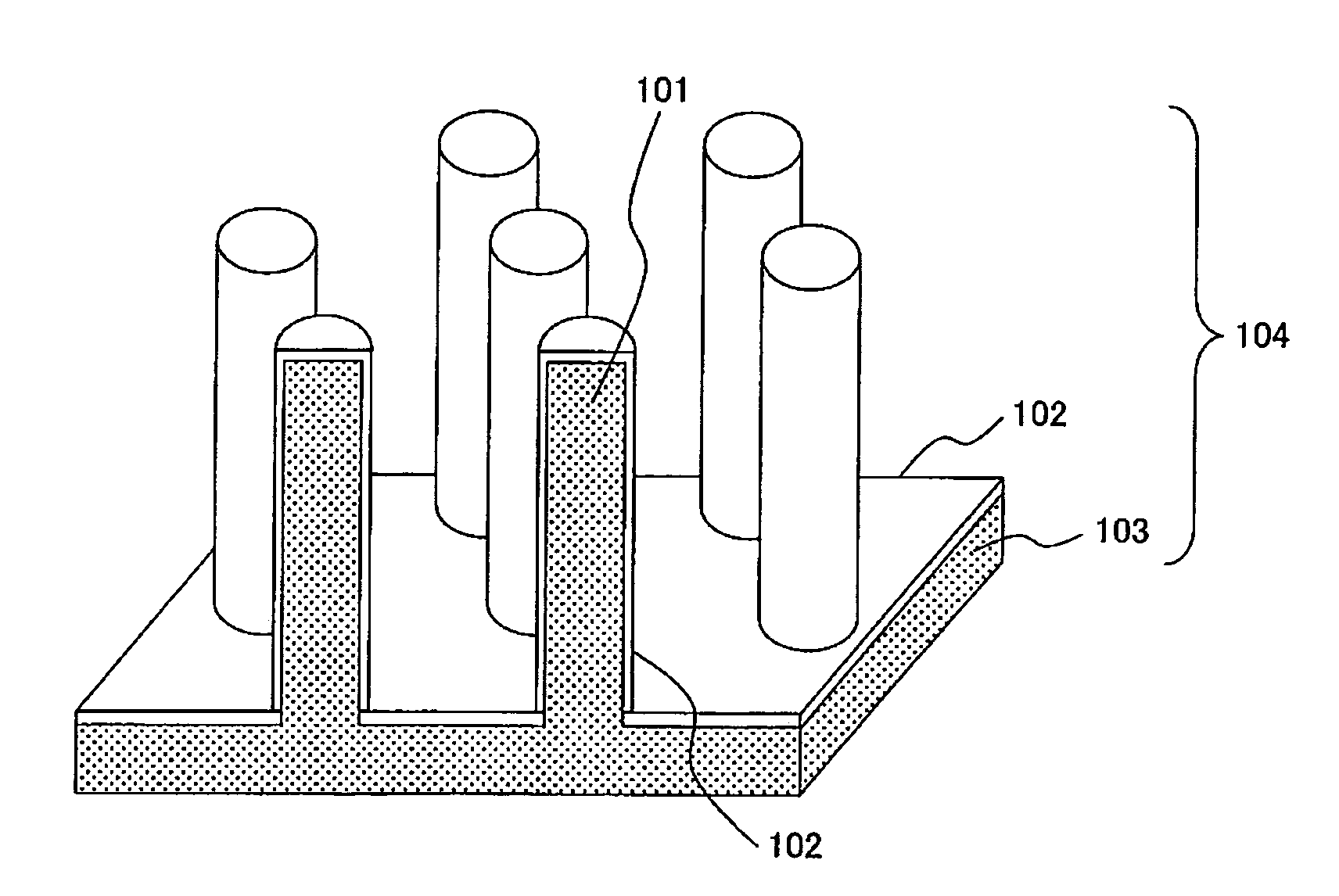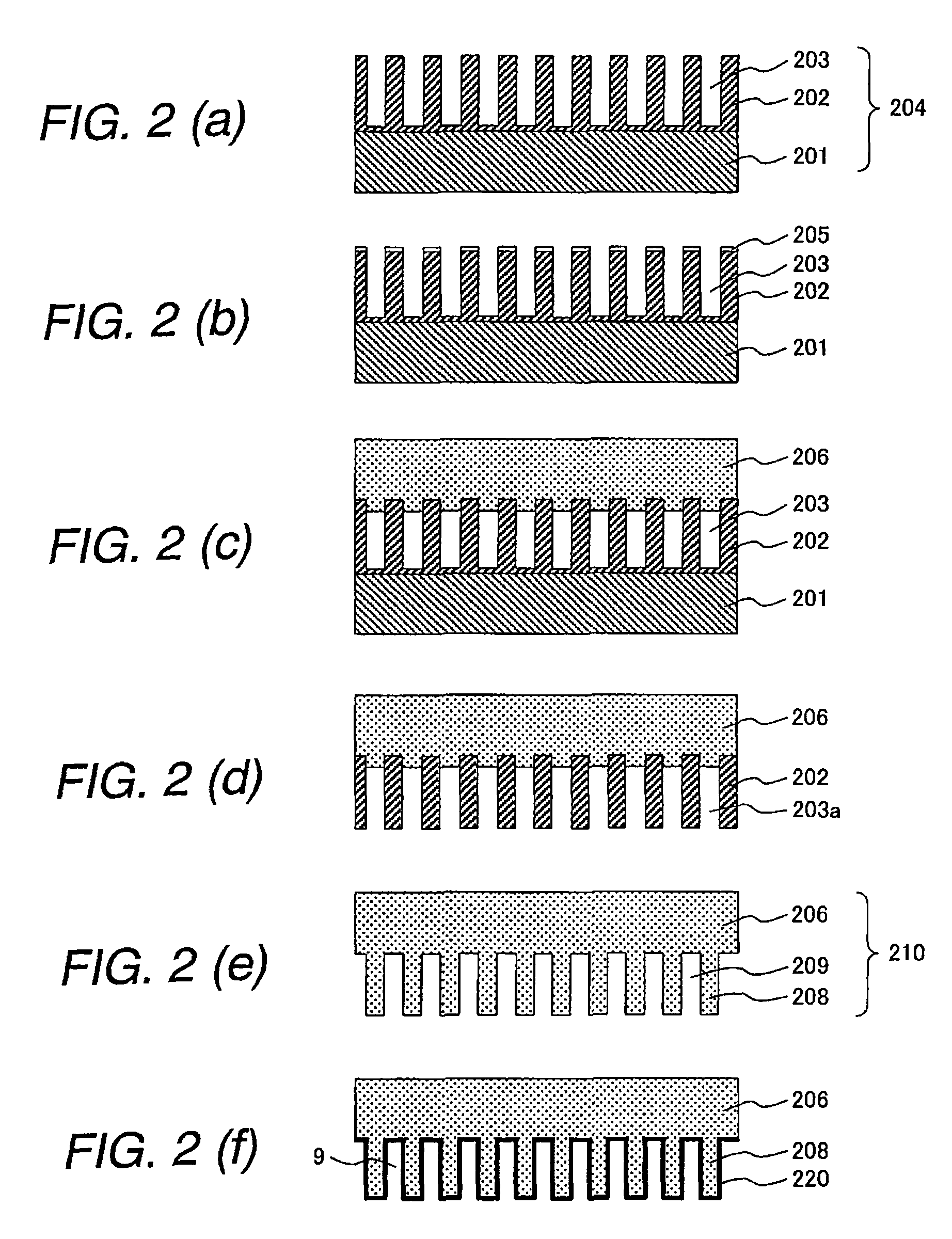Electrode for use in electrochemical device, solid electrolyte/electrode assembly, and production method thereof
a technology for electrochemical devices and electrochemical components, applied in the direction of surface reaction electrolytic coating, electrolytic inorganic material coating, fuel cells, etc., can solve the problems of high resistance, increase the active material not contributing to the electrode reaction, and cannot be said to be utilized effectively, so as to improve the capacity density of the electrode and the resistance of the electrode
- Summary
- Abstract
- Description
- Claims
- Application Information
AI Technical Summary
Benefits of technology
Problems solved by technology
Method used
Image
Examples
example 1
[0059]FIG. 1 is a perspective view showing an example of an electrode for use in electrochemical device according to the invention. An electrode 104 comprises a metal structure 103 having a group of micro-pillars 101 formed on the surface thereon, and an electrode active material 102. While the shape of the micro-pillar is a cylindrical columnar in FIG. 1, it may be a square cylindrical columnar (pillar) 302, and cylindrical columnar pillars and square cylindrical columnar pillars may also be present together. There is no particular restriction for the micro-pillars.
[0060]The electrode for use in electrochemical device of the shape shown in FIG. 1 was produced by production steps shown in FIGS. 2A to 2F.
[0061]FIG. 2A shows a substrate having pores. The substrate can be formed by anodic oxidation of an aluminum plate 201 in an acidic solution, for example, a solution of oxalic acid, chromic acid, or sulfonic acid. Anodized alumina 202 is formed on the surface of the aluminum plate 20...
example 2
[0068]In this example, a metal structure comprising nickel was produced by the same method as in Example 1, and ruthenium and platinum were formed as an active material onto the surface of micro-pillars comprising nickel. Specifically, by electrodepositing a metal structure in an aqueous alkali solution containing 0.05 mol / dm3 of ruthenium chloride, a ruthenium metal film was formed on the surface of the micro-pillar. Ruthenium was electrodeposited potentiostatically while measuring a current such that the surface thickness of nickel was about 5 nm.
[0069]Successively, platinum was deposited on the surface of the ruthenium metal film by electrodeposition using a pulse current in an aqueous solution containing 0.03 mol / dm3 of chloroplatinate. Granular platinum could be formed on the surface of the ruthenium metal film.
[0070]FIG. 5 shows a perspective view of an obtained electrode. A ruthenium metal film 502 was formed directly on the surface of each micro-pillar 208 of the metal struc...
example 3
[0072]In this example, a metal structure having micro-pillars was produced by the same method as in Example 1, and a multilayered layer comprising a ruthenium metal film and a ruthenium oxide film was formed on the surface of micro-pillars comprising nickel.
[0073]Specifically, by electrodepositing the metal structure in an aqueous alkali solution containing 0.05 mol / dm3 of ruthenium chloride, a ruthenium metal film was formed on the surface. Successively, by electrochemical oxidation in a solution of sodium hydroxide, the surface portion of the ruthenium metal film was oxidized to form a ruthenium oxide film. The solution is not restricted to that of sodium hydroxide so long as it is an aqueous alkali solution.
[0074]Also in this example, since the active material can be formed directly to the conductive skeleton, a conducting aid for connecting the active materials to each other may not be added at all. The electrode of this example can be provided as a high performance capacitor el...
PUM
| Property | Measurement | Unit |
|---|---|---|
| height | aaaaa | aaaaa |
| diameter | aaaaa | aaaaa |
| height | aaaaa | aaaaa |
Abstract
Description
Claims
Application Information
 Login to View More
Login to View More - R&D
- Intellectual Property
- Life Sciences
- Materials
- Tech Scout
- Unparalleled Data Quality
- Higher Quality Content
- 60% Fewer Hallucinations
Browse by: Latest US Patents, China's latest patents, Technical Efficacy Thesaurus, Application Domain, Technology Topic, Popular Technical Reports.
© 2025 PatSnap. All rights reserved.Legal|Privacy policy|Modern Slavery Act Transparency Statement|Sitemap|About US| Contact US: help@patsnap.com



